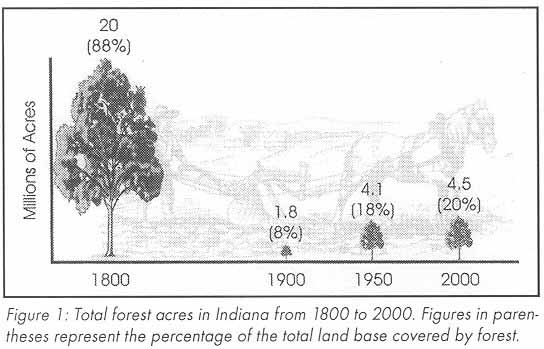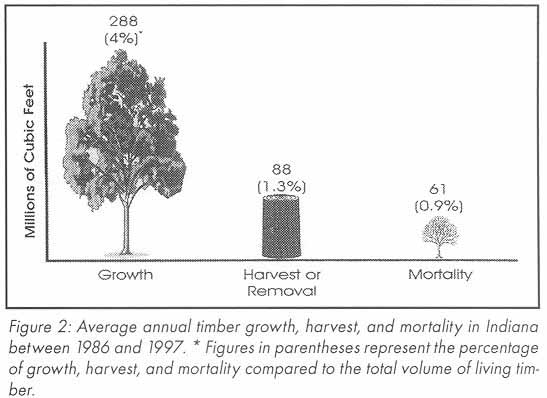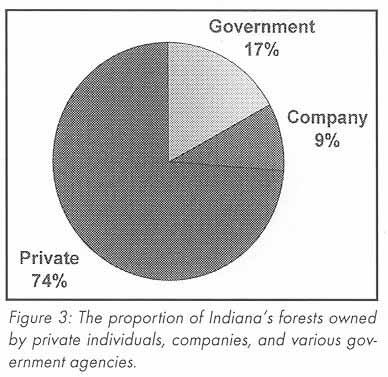
Summer 2002 Volume II, Number 2
SUSTAINABLE FORESTRY – WHAT DOES IT MEAN FOR INDIANA?
By Ron Rathfon, Department of Forestry and Natural Resources, Purdue University
The dictionary defines the word "sustain" as "to keep something going," or "to keep it in effect." No time limit is specified and, therefore, one might conclude that it (whatever "it" might be) could be kept going as long as necessary or possibly indefinitely 'Forestry is the art and science of caring for a forest to meet the needs of the owners and those of society. Sustainable forestry, therefore, refers to caring for or managing forests in such a way that they continue to play the desired role and produce desired benefits as long as necessary or possibly indefinitely. Simply stated, sustainable forestry is managing forests to meet the needs of today while pro-viding the needs of future generations.
Value of Indiana's Forests
No one can deny the value of our forests. We live in homes
constructed largely of wood and often trimmed and decorated with wood. We use a
host of paper products from newspapers, books, and magazines to bags, boxes, and
toilet paper.
Wood products manufacturing has historically been important to Indiana's economy and remains so today. It is the fifth largest industry in the state, employing close to 50,000 people. The economies of many Indiana communities are heavily dependent on wood manufacturing, and thus the forests supplying those industries. Outdoor recreation and nature-based tourism are growing industries in Indiana. These emerging industries most often depend on the scenic beauty and the wildlife that forests provide.
Numerous species of wild mammals, birds, reptiles, and amphibians depend on our forests for cover, nesting, and feeding. Forests provide the primary hunting grounds for Indiana hunters. Bird watching is an increasingly popular Hoosier pastime.
Less tangible in terms of economic importance but nonetheless vital to human and societal good health are the environmental benefits of forests. Forests help combat global warming. Leaf surfaces filter dust, ash, and pollen from the air, as much as 13 tons per acre each growing season, helping us all breathe a little easier. Forests protect soil and filter storm water runoff, protecting municipal water supplies and important fisheries and recreational lakes. Forests dazzle our senses, spiritually invigorating us. They are a refuge of tranquility in our frenzied, high-tech world. How can we put a price tag on these benefits?
Historical Perspective
Today many of our forests are managed sustainably. Historically, most of Indiana's forests were cleared, burned, heavily grazed, and over-logged. With the commencement of frontier settlement at the dawn of the 19th century, Indiana had over 20 million acres of forests covering about 87 percent of the land. The forest proved invaluable to providing for the pioneers' need for home and barn building materials, fences, fuel for cooking and heating, barrels, tools, and machinery. Nonetheless, forests were also viewed as a threat, harboring Indians and dangerous wild beasts, and as a hindrance to progress. Forests needed to be cleared for crop fields and pastures, roads, businesses, and towns.

Deforestation accelerated through the 19th century and into the early 20th century, clearing forests at an average rate of over178,000 acres/year over a 100 year span. By 1900 only 8 percent, or 1.8 million acres, of Indiana remained covered by remnant forests. Those remnant forests were growing on land that was too steep or too wet to farm. Though not cleared, they were often grazed, burned, and almost certainly heavily logged.
Our forests recovered throughout the latter half of the 20th century. Eroded crop fields and pastures were abandoned and left to grow back into forest. Many acres of worn-out farmland in southern Indiana were planted to white, Virginia, shortleaf, and red pine. As the forests grew back, the land healed, soil productivity was partially restored. and wildlife returned. Although a small amount of forest is still cleared for agriculture in Indiana, it is offset by tree planting and reverting marginal crop and pasture land.

Indiana's Forests Today
Today 4.5 million acres of forest shade 20 percent of Indiana. Well over 150,000 private individuals own 74 percent of the state's forestland. Approximately 17 percent is under federal, state, and municipal management. The remaining 9 percent of Indiana's forests are owned by corporations. The amount of forest under professional forest management continues to grow. Currently timber in Indiana grows at 2.5 times the rate it is cut. The logging profession continues to improve safety and timber harvesting practices through state-sponsored training programs. Foresters in the Indiana Division of Forestry inspect over 400,000 acres of forest every five years under the Classified Forest Program. Thousands more acres of privately owned forest are managed with the assistance of private consulting and timber company foresters.
 There
are new challenges to the health of Indiana's forests. Suburban sprawl, new
roads and utilities, and the parceling of larger forested tracts
into house lots are all eroding recent gains in forest land. This modern form of
forestland conversion is, for all practical purposes, irreversible. It is the
greatest threat to Indiana's forests today.
There
are new challenges to the health of Indiana's forests. Suburban sprawl, new
roads and utilities, and the parceling of larger forested tracts
into house lots are all eroding recent gains in forest land. This modern form of
forestland conversion is, for all practical purposes, irreversible. It is the
greatest threat to Indiana's forests today.
A growing population and a more highly sensitized public continue to demand more wood and more outdoor recreation opportunities while at the same time insisting that forests be managed with greater "environmental sensitivity." Providing suitable habitat for threatened and endangered species may have an enormous impact on how both public and private forestland is managed. Global warming and the predicted changes in our climate may have a detrimental impact on forest health.
Sustainable forestry recognizes the many benefits we derive from our forests and incorporates them into management practices. It provides for greater financial returns over a long period for landowners while still protecting soil and water, providing wildlife habitat and recreation opportunities, and conserving our natural and cultural heritage. It helps provide for the economic and social stability of forest-dependent communities. Sustainable forestry helps ensure healthy, productive forests will be passed on to future generations.
Sustainable Forestry Objectives
YOU, the forest landowner, play a vital role in sustaining Indiana's forests. Table 1 contains a list of objectives you should consider as you strive to manage your forest sustainably.
How This Sustainable Forestry Series is Organized
The remaining seven parts of this eight-part series of Purdue Cooperative Extension publications, entitled A Landowner's Guide to Sustainable Forestry in Indiana, correspond to the seven major objectives of sustainable forest management identified in Table 1.Each publication in the series is subdivided into sections that describe specific management activities that contribute to the major sustainable forest management objective being addressed. For quick, easy reference, checklists are provided to summarize those specific management activities. Text describing these activities is brief. However, sources of additional information are provided at the end of each publication in this series. Terms that may be new to many landowners are printed in bold typeface the first time they are used and then defined or described within the some paragraph. Inside the back cover of Part 8, Help!, separate, removable inserts provide up-to-date contact information for the many agencies and organizations ready to serve your sustainable forest management needs. A list of useful WEB sites is also provided.
A Word of Caution
Many attempts have been made to define sustainable forestry. In fact, what management practices constitute sustainable forestry is the subject of considerable debate among foresters, environmental advocates, the timber industry, landowner organizations, and other conservation-minded people.
This Guide to Sustainable Forestry series does not attempt to resolve these differences of opinion. In fact, we do not claim that this series provides the final definition of sustainable forestry for Indiana. To do so would be to claim that we have the proverbial "shoe to fit all sizes." The guidelines presented here are not stern regulations to be strictly adhered to. Rather, they are suggestions to aid you as you make important forest management decisions. You, and the natural resource professionals you work with, must tailor management prescriptions to fit your unique circumstances. The guide provides you with an initial overview of sustainable forestry in Indiana and serves as a reference for your future information needs.
Whether you have been actively involved in managing your forest for many years or you have just acquired forest property for the first time, we hope you find this guide useful.
Acknowledgements
This Sustainable Forestry publication series was supported with funds from the USDA Fund for Rural America Program administered by the Cooperative State Research, Education, and Extension Service. The authors would like to acknowledge the assistance of The Nature Conservancy and Virginia Polytechnic Institute and State University, partners with Purdue University on this project.
Additional Information
Fix, W.L. 1993. The Forests of Indiana. Purdue University Cooperative Extension Service, FNR-34. 3 p.
Schmidt, T.L., M.H. Hansen, and J.A. Solomakos. 2000.
Indiana's Forests in 1998. USDA Forest Service, North Central Research Station, Resource Bulletin NC-196. 139 p. Tormoehlen, B., J. Gallion, and T.L. Schmidt. 2000. Forests of Indiana: A 1998 Overview USDA Forest Service, Northeast Area State & Private Forestry, NA-TP-03-00. 18 p.
Table 1. Objectives for Owners of Sustainable Forests in Indiana
1 . Become acquainted with your forest resources, become involved in the long-range planning and management of those resources, and obtain professional help where you need it.
2. Maintain the health and productivity of your forest while pro-viding a continuous supply of quality hardwood timber.
3. Conserve nature.
4. Provide clean water.
5. Maintain the beauty of your forest, enhance its recreational value, and protect historical and cultural sites on your forest.
6. Recognize and develop alternative, sustainable, forest-based, income-producing enterprises that reward you financially and add value to the local economy.
7. Take advantage of educational opportunities, financial incentives, and technical assistance available to you to help you achieve your sustainable forestry goals.